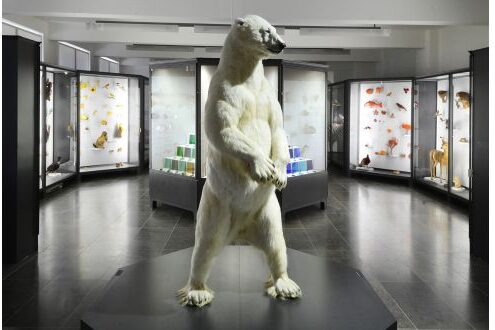Natural History Collections of the Museum Wiesbaden
Since 2013, the natural history collections of the Museum Wiesbaden have been presented under the title "Aesthetics of Nature". Founded in 1829, the exhibitions of the former Natural History Museum were housed in the Erbprinzenpalais for almost 100 years.
The natural history collections of the Wiesbaden Museum were founded in 1829 as an independent natural history museum by the "Verein für Naturkunde im Herzogthum Nassau" (later the Nassauischer Verein für Naturkunde) and is one of the oldest civic natural history museums. Rooms in the Erbprinzenpalais were used until 1915. It then moved to what is now the Landesmuseum on Friedrich-Ebert-Allee.
The insect collection of Johann Christian Gerning was one of the most important acquisitions of the early years. On the initiative of Goethe(Goethe in Wiesbaden), this was given to the museum by Gerning's son, Johann Isaak von Gerning. It contains collections of the natural scientist and artist Maria Sibylla Merian. Even at the beginning, the donations and acquisitions went beyond the boundaries of Nassau. Count Brune de Mons (Havana) and Ernst Albert Fritze (Jakarta), for example, sent numerous exotic animals to Wiesbaden, including Java tigers and Sumatran rhinoceroses. Friedrich Albert Pompejus von Arnoldi, Anton Vigener and Carl Ludwig Kirschbaum in particular built up the local collections. Arnold Pagenstecher published the first scientific descriptions of exotic butterflies. He was also one of the many volunteers who supported the museum over many years.
The first state geologist Carl Koch bequeathed his geological-palaeontological collection to the museum. He carried out the first investigations into the geology and mapping of Nassau. Thanks to his studies, Wiesbaden received a secure water supply. The geologist August Leppla also devoted himself to the museum's geological and mineralogical collections from 1915. The palaeontological collections still contain mainly finds from the Devonian, Tertiary and Pleistocene (Mosbach sands), i.e. the Mainz Basin and the Taunus. Important palaeontologists include the brothers Guido Sandberger and Fridolin von Sandberger, who were the first to study the geological history of the region.
The initial exhibitions concentrated on systematics. It was not until the 20th century that ecology and evolution were addressed. Thanks to an aquarium, the people of Wiesbaden also had intensive contact with the museum and special exhibitions supplemented the regular offerings. In the 21st century, the growing interest in art must also be taken into account. Thematic intersections such as color and form were taken up. Since 2013, the collections have been presented in the newly designed exhibition entitled "Aesthetics of Nature".
With more than one million objects, the museum now has an important store of scientific knowledge on topics such as systematics, biodiversity, ecology and geography. In addition to geology, botany and zoology, ethnological collections are also represented. The specialist library with thousands of books is available to scientists and the general public. New media are also used to impart knowledge.
Literature
175 Jahre Nassauischer Verein für Naturkunde und Naturwissenschaftliche Sammlung des Museums Wiesbaden 1829- 2004. Jahrbücher des Nassauischen Vereins für Naturkunde 125, Wiesbaden 2004.
